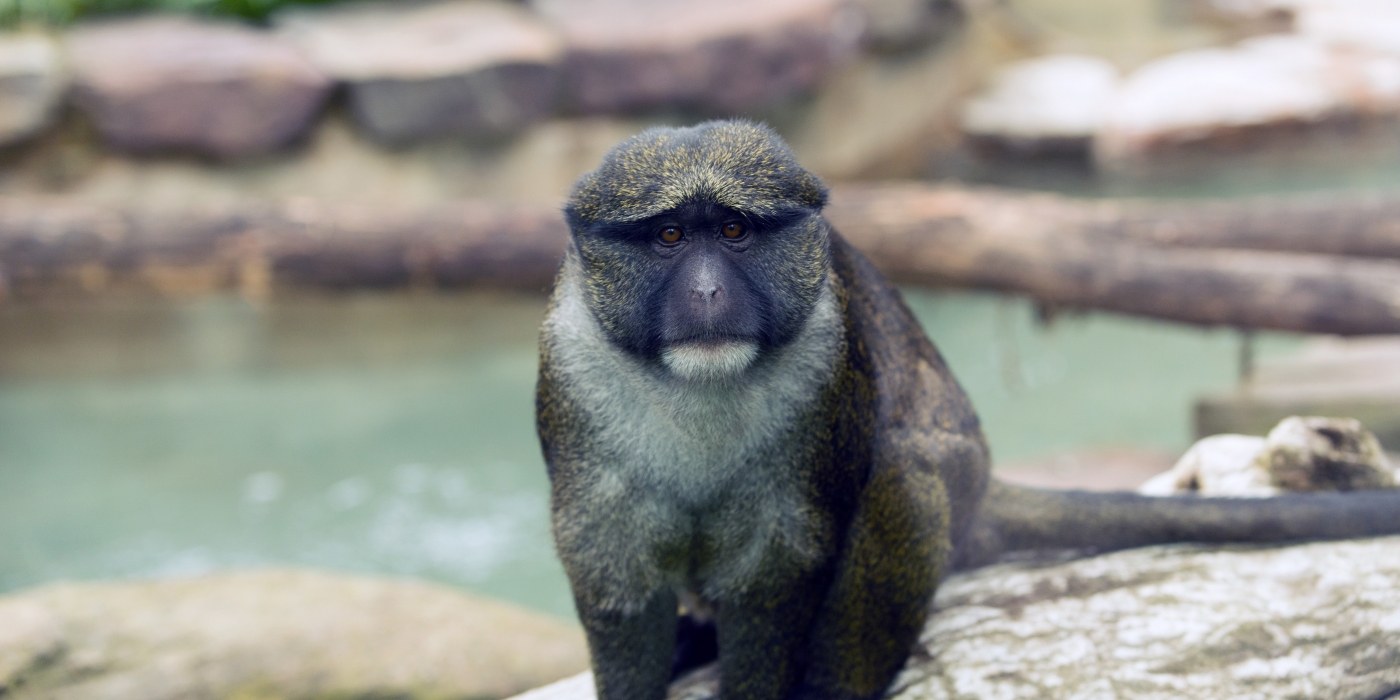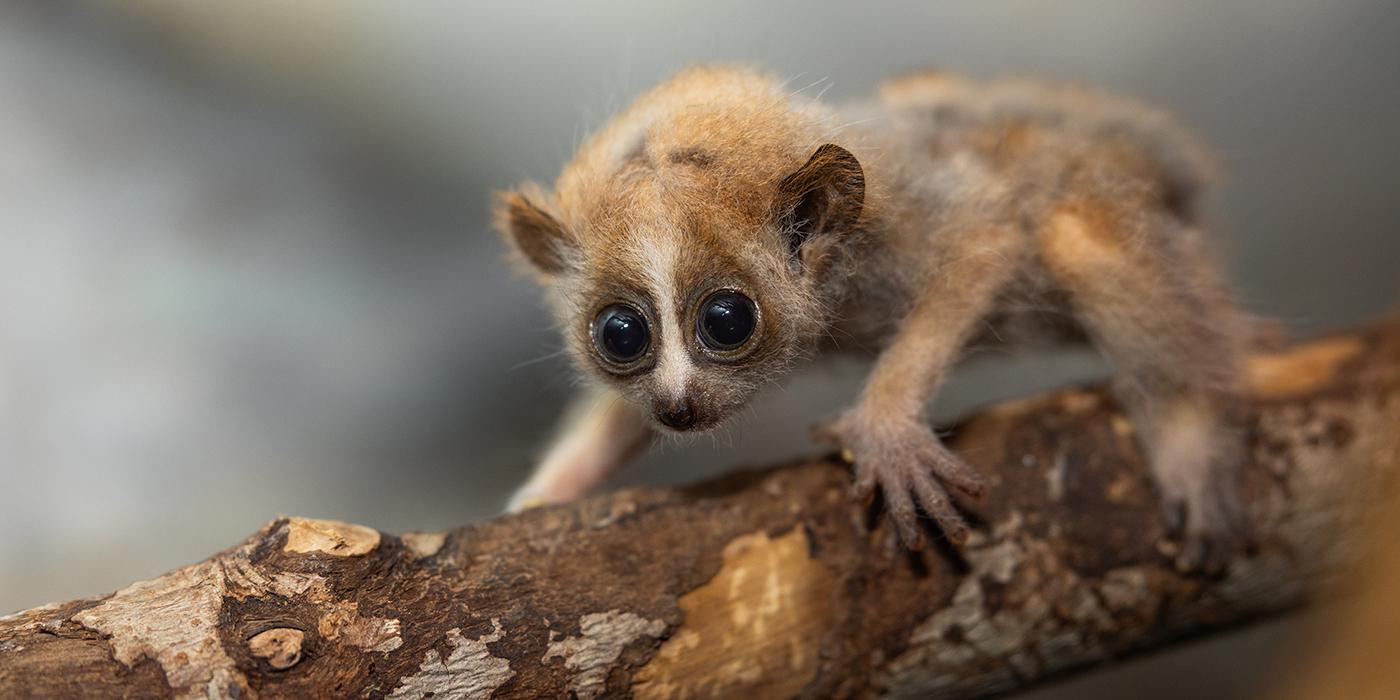Primates and Peanuts: Testing Tool IQ
Two peanuts sit on a tray. One is beneath the curve of a tool; the other is beside a different tool, out of reach. Smithsonian’s National Zoo’s Allen’s swamp monkey Nub Armstrong is eyeing both. Will he pick the tool that brings the peanut toward him? To examine whether guenons understand how tools work, primate keeper Erin Stromberg and University of Michigan graduate student Missy Painter have teamed up to put these monkeys’ smarts to the test.
What sparked your interest in studying guenon tool use?
Painter: As humans, we use tools every day, and we understand what makes a tool useful—that it has a causal effect on something else in the environment. For example, we know that when we rake the yard, pulling the rake causes it to act on the leaves beneath it and move them toward us.
Some primates, like chimpanzees and capuchin monkeys—use tools in the wild to access food. But, do they understand the physics behind what allows their tools to work, like humans do? Might other primate species be able to learn these types of rules about the physical world, even if they do not use tools in the wild?
As guenons are not known to regularly use tools in the wild, testing them in tool-choice tasks helps us answer this second question. We do know that they are very dexterous, manipulating many things in their environment. There are reports of wild guenons using leaves to remove sticky substances from their fingers and laying leaves on top of the water to catch fish that are attracted to the leaves. They are clever monkeys, for sure!
How do you test their tool IQ?
Painter: We present the Allen’s swamp monkeys with a choice between two rake-like tools that are almost exactly the same. One of the tools is properly positioned to retrieve a piece of food when the monkey pulls the tool toward himself or herself; the other is not.
We keep track of how long it takes the monkeys to learn to choose the correct tool. While they are leaning which tools enable them to retrieve the rewards, we can get a sense of which aspects of the tools draw their attention.
Next, we present them with a different tool shape to see if they can transfer what they have learned to a new (but similar) problem. If they succeed, this means they learned something about what kinds of objects can act as tools, and how they should interact with these objects to achieve a goal. In this case, to get a treat!
Ultimately, we, we can assess whether they learn the casual relationship between pulling the tool and receiving the reward. Do the monkeys that have learned to choose the correct tools really understand how a tool works? Or, do they use some other cue to pick the correct tool?
Do guenons usually use tools at the Zoo?
Stromberg: Think Tank—the exhibit where the guenons live—focuses on three main themes: language, society and tool use. Our Allen’s swamp monkeys and Schmidt’s red-tailed monkeys have never shown keepers that they understand the concept of using a tool to get a reward. Involving them in this study, though, could help us learn more about their understanding of tool use.
Some of the enrichment items the monkeys receive require some aspect of problem-solving in order to obtain a reward. The information we learn from this study could shape the types of enrichment we provide them in the future.
All of the research projects that we do with our primates use operant conditioning. That means that the animals’ participation in the study is voluntary and, at any point, they have the choice and opportunity to walk away. If they do elect to participate, then they receive a reward, typically in the form of food. Most of our primates that qualify for these studies eagerly participate—especially when peanuts are offered as a reward!
How did the guenons react to the tools?
Stromberg: As with all primate cognitive studies, the individual personalities of each guenon really shines through.
Before one of our female Schmidt’s red-tailed monkeys, Chi Chi, moved to another Zoo, she participated in this study in the summer and fall of 2018. She seemed to enjoy the test but did not like the sound that the tools made when they came into contact with the exhibit mesh. We added a towel “bumper” to soften the sound.
Our male Allen’s swamp monkey, Nub Armstrong, will do just about anything for a peanut. He often gets very impatient and will push on the box that hides the tools in between trials, desperate to make the peanuts appear sooner!
Did their knack for using tools surprise you?
Painter: Considering that this is the guenons’ first cognitive study at the Zoo, they took to the task pretty quickly. The number of initial training sessions they needed in order to consistently choose the correct tool was within the same range as that of a group of capuchin monkeys at Bucknell University that have participated in cognitive tasks for years!
Stromberg: I was very impressed that each of the guenons eagerly separated from their group to participate in the study, even though the tools were foreign to them, both in material and color. They demonstrated a strong desire to participate and didn’t hesitate to sit in front of and interact with these strange-looking tools!

What’s next for this study?
Painter: It has been exciting to see that this study was possible with monkeys that did not have prior experience participating in research and cognitive testing. This suggests that it would be possible to test a wide variety of primates—with varying degrees of experience with cognitive testing—to learn more about how different primate species understand tools and the physical environment around them.
What do you enjoy most about this research?
Stromberg: One of the coolest things about this study is that our guenons are among the first of their species to participate. Very little information is published about guenons’ cognitive skills. To them, this study is another opportunity to interact with enrichment and receive a reward for doing so—it is just a fun activity. But, for the scientific community, studies like this offer us greater insight into the guenons’ cognitive abilities as a whole. The subject of tool use still has many unanswered questions. But, with this research, we are steps closer to understanding why and how some animals use tools and others do not.
This story appears in the May 2019 issue of National Zoo News. Painter began this research as a Master’s student in the Animal Behavior Program at Bucknell University.
Related Species:




